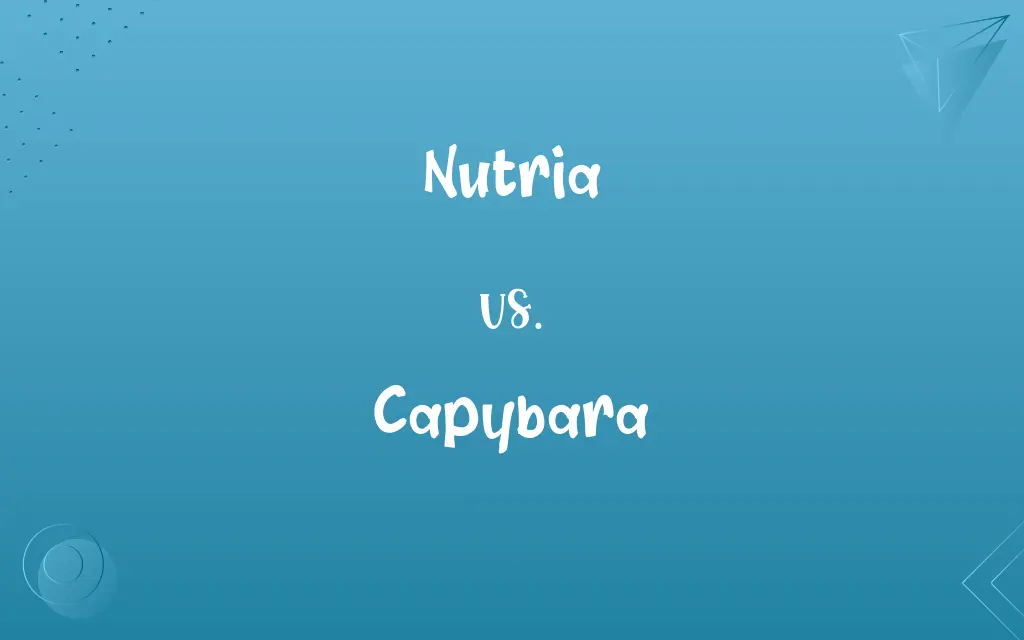Nutria vs. Capybara: Know the Difference

By Shumaila Saeed || Updated on December 25, 2023
Nutria are smaller, semi-aquatic rodents native to South America, often farmed for fur, while capybaras are the world's largest rodents, social and native to South America, living near water bodies.

Key Differences
Nutria, also known as coypu, are medium-sized, semi-aquatic rodents originally from South America. They are known for their valuable fur and have been introduced to various parts of the world. Capybaras, on the other hand, hold the title of the largest living rodents, also originating from South America. They are noted for their social behavior and preference for living in groups near water bodies.
Shumaila Saeed
Dec 03, 2023
The physical appearance of nutria and capybaras differs significantly. Nutria typically weigh between 5 to 10 kilograms and have coarse, brown fur. Their tails are round and scaly. Capybaras are much larger, weighing up to 60 kilograms, with dense, reddish-brown fur and webbed feet, adapting them better to aquatic environments.
Shumaila Saeed
Dec 03, 2023
Nutria have become an invasive species in many regions, causing environmental damage due to their burrowing and feeding habits. They are often considered pests. Capybaras, while also having a significant environmental impact, are generally viewed more positively, often being a subject of fascination and tourist attraction in their native habitats.
Shumaila Saeed
Dec 03, 2023
In terms of diet, both nutria and capybaras are herbivores, but nutria are more likely to cause agricultural damage due to their feeding on crops. Capybaras have a diverse diet, feeding mainly on grasses and aquatic plants, and they play a vital role in their ecosystem as prey for larger predators.
Shumaila Saeed
Dec 03, 2023
Reproduction patterns of nutria and capybaras also differ. Nutria reproduce rapidly, which contributes to their status as pests in non-native regions. Capybaras have a slower reproduction rate, with a more structured social hierarchy influencing mating behaviors.
Shumaila Saeed
Dec 03, 2023
ADVERTISEMENT
Comparison Chart
Habitat
Semi-aquatic, invasive in many areas
Aquatic, native to South America
Shumaila Saeed
Dec 03, 2023
Social Behavior
Less social, solitary or small groups
Highly social, lives in large groups
Shumaila Saeed
Dec 03, 2023
Environmental Impact
Considered pests, damage ecosystems
Less invasive, part of ecosystem
Shumaila Saeed
Dec 03, 2023
ADVERTISEMENT
Nutria and Capybara Definitions
Nutria
An invasive species in many parts of the world, causing environmental concerns.
Efforts to control the nutria population are ongoing due to their impact on local ecosystems.
Shumaila Saeed
Nov 27, 2023
Capybara
Known for their social nature, living in groups and communicating through various vocalizations.
The capybara group communicated through a series of barks and whistles.
Shumaila Saeed
Nov 27, 2023
Nutria
Known for their rapid reproduction and adaptability to various environments.
Nutria have thrived in new habitats, partly due to their high reproductive rate.
Shumaila Saeed
Nov 27, 2023
Capybara
The largest living rodent, native to South America and found near water.
Capybaras are often seen lounging by the riverbank in large family groups.
Shumaila Saeed
Nov 27, 2023
Nutria
A semi-aquatic, medium-sized rodent native to South America.
The nutria, often mistaken for a beaver, was spotted near the riverbank.
Shumaila Saeed
Nov 27, 2023
ADVERTISEMENT
Capybara
An important part of their ecosystem, serving as prey for predators like jaguars.
In the food chain, capybaras are crucial prey for many large South American predators.
Shumaila Saeed
Nov 27, 2023
Nutria
A species known for its dense fur, historically valued in the fur industry.
Nutria fur coats were once a fashionable item in cold climates.
Shumaila Saeed
Nov 27, 2023
Capybara
Herbivorous, primarily feeding on grasses and aquatic plants.
The capybara grazed on the grass near the water's edge.
Shumaila Saeed
Nov 27, 2023
Nutria
A rodent with a distinctive round, scaly tail and webbed back feet.
The nutria's tail is a key feature distinguishing it from other similar rodents.
Shumaila Saeed
Nov 27, 2023
Capybara
Characterized by their dense, reddish-brown fur and webbed feet for swimming.
The capybara's webbed feet make them excellent swimmers.
Shumaila Saeed
Nov 27, 2023
Nutria
A large semiaquatic rodent (Myocastor coypus) native to South America, having webbed feet and a long tail. It is widely raised for fur and has formed wild populations especially in the southern United States.
Shumaila Saeed
Oct 19, 2023
Capybara
A large semiaquatic rodent (Hydrochoerus hydrochaeris) of tropical South America, having short limbs and a vestigial tail and often attaining lengths of more than 1.2 meters (4 feet).
Shumaila Saeed
Oct 19, 2023
Nutria
The light brown fur of the nutria. In both senses also called coypu.
Shumaila Saeed
Oct 19, 2023
Capybara
A semi-aquatic South American rodent, Hydrochoerus hydrochaeris, the largest living rodent.
Shumaila Saeed
Oct 19, 2023
Capybara
A large South American rodent (Hydrochærus capybara) Living on the margins of lakes and rivers. It is the largest extant rodent, being about three feet long, and half that in height. It somewhat resembles the Guinea pig, to which it is related; - called also cabiai and water hog.
Shumaila Saeed
Oct 19, 2023
Capybara
Pig-sized tailless South American amphibious rodent with partly webbed feet; largest living rodent
Shumaila Saeed
Oct 19, 2023
Nutria
Aquatic South American rodent resembling a small beaver; bred for its fur
Shumaila Saeed
Oct 19, 2023
Repeatedly Asked Queries
Do capybaras live in groups?
Yes, capybaras are highly social and live in large groups.
Shumaila Saeed
Dec 03, 2023
What kind of damage do nutria cause to the environment?
Nutria damage ecosystems through burrowing and feeding habits.
Shumaila Saeed
Dec 03, 2023
Can nutria adapt to different environments?
Yes, nutria are highly adaptable to various environments.
Shumaila Saeed
Dec 03, 2023
What is the habitat preference of capybaras?
Capybaras prefer habitats near water bodies.
Shumaila Saeed
Dec 03, 2023
Where are nutria originally from?
Nutria are originally from South America.
Shumaila Saeed
Dec 03, 2023
Are capybaras aquatic animals?
Capybaras are semi-aquatic and spend a lot of time in water.
Shumaila Saeed
Dec 03, 2023
What is the social structure of capybaras like?
Capybaras have a structured social hierarchy within their groups.
Shumaila Saeed
Dec 03, 2023
What type of fur do capybaras have?
Capybaras have dense, reddish-brown fur.
Shumaila Saeed
Dec 03, 2023
What is the typical size of a capybara?
Capybaras can weigh up to 60 kilograms.
Shumaila Saeed
Dec 03, 2023
Are nutria considered an invasive species?
Yes, nutria are invasive in many regions.
Shumaila Saeed
Dec 03, 2023
What is the lifespan of a nutria in the wild?
Nutria typically live for 3 to 6 years in the wild.
Shumaila Saeed
Dec 03, 2023
What do nutria eat?
Nutria are herbivores, known to feed on crops and vegetation.
Shumaila Saeed
Dec 03, 2023
Can capybaras be domesticated?
Capybaras are not typically domesticated, but they can be tame around humans.
Shumaila Saeed
Dec 03, 2023
What role do capybaras play in their ecosystem?
Capybaras play a vital role in their ecosystem, particularly as prey for larger animals.
Shumaila Saeed
Dec 03, 2023
How do capybaras communicate?
Capybaras communicate through various vocalizations.
Shumaila Saeed
Dec 03, 2023
Do capybaras have any natural predators?
Yes, capybaras are prey for predators like jaguars and caimans.
Shumaila Saeed
Dec 03, 2023
Are nutria a threat to agriculture?
Yes, nutria can cause significant agricultural damage.
Shumaila Saeed
Dec 03, 2023
What is the impact of nutria on native wildlife?
Nutria can negatively impact native wildlife and habitats.
Shumaila Saeed
Dec 03, 2023
Share this page
Link for your blog / website
HTML
Link to share via messenger
About Author
Written by
Shumaila SaeedShumaila Saeed, an expert content creator with 6 years of experience, specializes in distilling complex topics into easily digestible comparisons, shining a light on the nuances that both inform and educate readers with clarity and accuracy.









































































